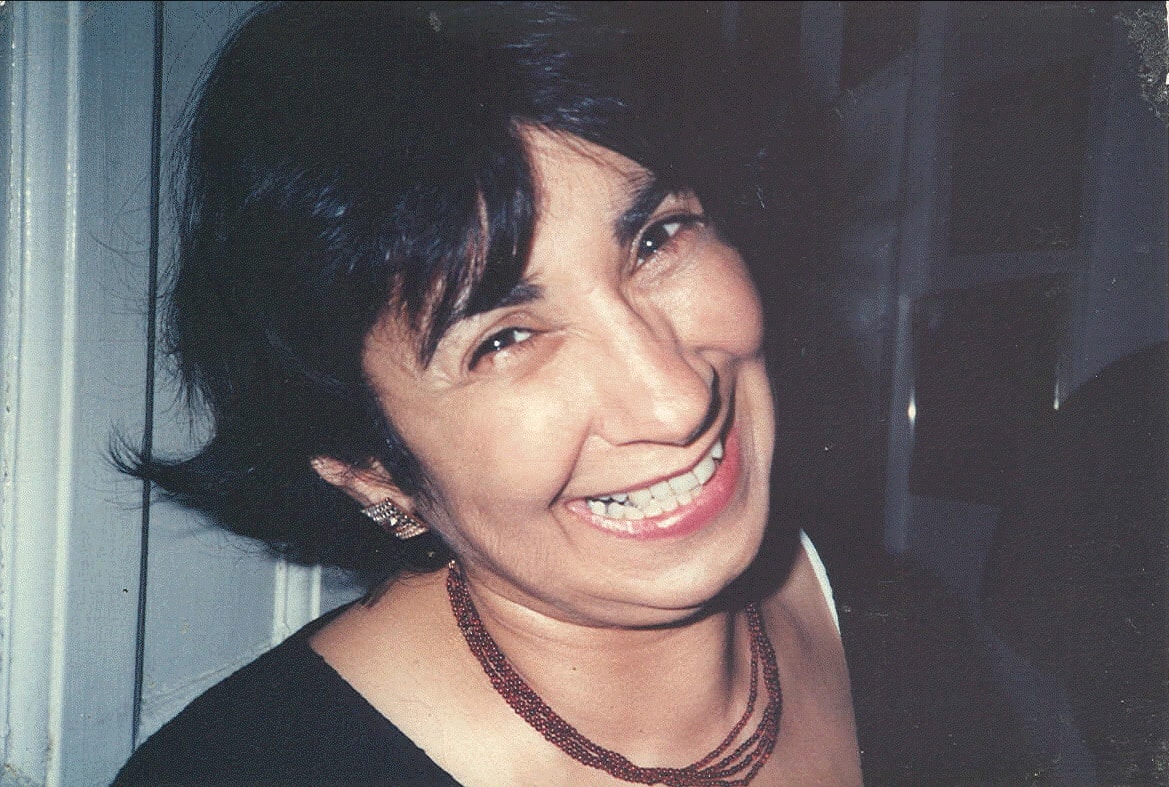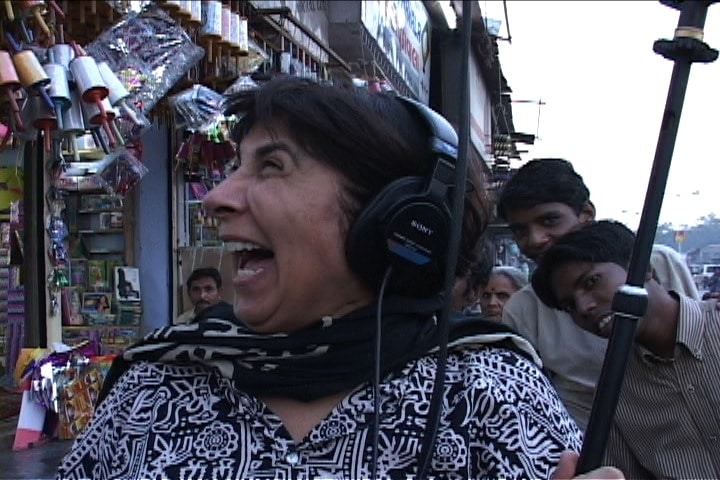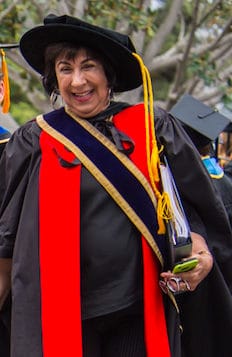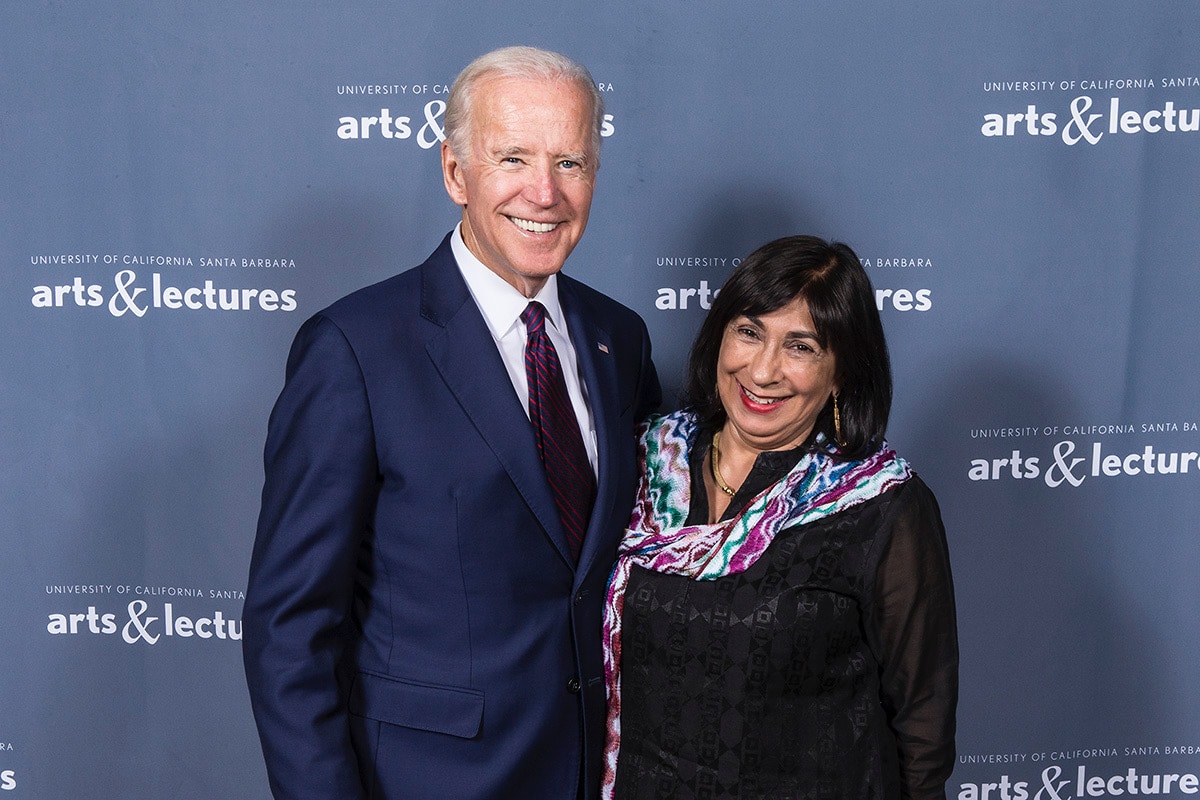
Kum-Kum Bhavnani
Distinguished Professor at the University of California, Santa Barbara (UCSB) and Former Chair of the University’s Academic Senate, Kum-Kum Bhavnani spoke with impactmania about her latest documentary Galapagos Life; filming physics courses for Tibetan Buddhist monks; and she reminds us that we should Lift While We Climb.
BY PAKSY PLACKIS-CHENG
Kum-Kum, I was watching your TED Talk and thinking, you must be pleased that there are so many angry people right now!
[Laughs.] Anger is an interesting emotion; I see anger as a desire for change. Yet, the problem with anger is that it can become bitterness. I think it’s a way to change a situation and to get to forgiveness. What I said in that talk is that if we act positively on our anger, we can get to the point where we need to be, which is to be able to forgive…
A lot of people are frustrated about the world right now, what are the best tools to engage? What would be a next step transforming anger toward change and forgiveness?
I think when we feel angry about what’s going on in the world, we instantly have to find groups and organizations that we can work with — groups that are doing something important. I think refugee issues are important. For instance, if I act on my anger about what is going on with the Rohingya minority in Burma, I can then start to work on making things better for that minority.
Someone might want to work on women’s rights. Someone else might want to work on children’s rights. And someone else might want to work on human trafficking. But let’s always find an organization where we can work together to channel our frustration/anger.
Let’s talk a bit about your documentaries.
I’m an academic and academics write books and articles. About 15 years ago, I decided that I wanted to see if I could disseminate my research as a documentary; and that is what I do now.
In 2006, my first documentary was released about women in Senegal, Brazil, India, and Jerusalem creating social justice around the world, The Shape of Water. The documentary is narrated by Susan Sarandon. My second is Nothing Like Chocolate in 2012.
Also narrated by Susan Sarandon!
[Laughs.] Yes, and then the third one is Lutah (2014). My latest documentary is Galapagos Life, a film about the people who live on the islands.
The very first time I went to the Galapagos, I went with my daughter, Cerina. Her school was going with five school students, on a boat with 11 students from Minnesota. One day, Cerina came home and said, “Mum, we need one more person. Otherwise we can’t go.” I looked at her and thought, “Yes!” I had to be that person.
Everyone flies from Guayaquil to the airport on Baltra Island. As we circled above that area, Cerina looked out of the window and said, “Mum, people live here!” She got me to realize “that many folks don’t remember there are people who live on the Islands”. So that captured my imagination. Later, when I started to systematically view documentaries about the Galapagos, I recognized there’s rarely any mention of people.
Why this film?
I have been back a few times and the documentary shows how the Galapaguenos are conserving the environment. It is focused on a very poor woman from the Galapagos who cleans in a hotel. We get to know her, her grown children, and her husband. In telling us the story of her life, every other issue in the world emerges, including eco-tourism and some of its contradictions.
I also show people talking about why they work as tourist guides. These are all people who are trying to protect the environment in the Galapagos so that the animals can live. Because of this, all of us who don’t live in the Galapagos may learn something and perhaps carry some of those ideas into our own communities.
For example, there is no water on the islands. It all has to be brought in; which means that all tourists bring in bottles of water. What do you do with those plastic bottles? How much can you recycle? Very creatively, there’s a group of young people who turned those water bottles into trash cans. You can make trash into something that’s actually quite artistic and also has a function. That’s an example of something we can bring back into all of our communities.
What has been surprising to learn for you producing and directing these documentaries?
There are two things. One is in terms of the content of the documentaries. I am constantly humbled by how much people do and give, just for the sake of taking care of their community, or the planet — the women in Shape of Water; Mott Green [the late social entrepreneur and founder of Grenada Chocolate Company] and the people around him. The architect, Lutah Maria Riggs [first woman in California to be named a Fellow of the American Institute of Architects]. She tried to design building sustainably, even though weren’t quite the words that they used in the 1950s.
My docs have allowed me to meet change makers, and to learn about some of the incredible things on in our world.
The other side is more personal, it’s that I never believed I could make a film. It’s a lot of work, there’s no question about it. But I love it, because although the director/producer is in charge, it’s a team effort. I have been working with the same camerawoman, same sound-recorders, and the same digital imaging producer for close to 10 years now!

Kum-Kum filming in Ahmedabad, India.
For some of these films, you’ve raised funds through Kickstarter?
For Chocolate and Galapagos I raised funds through Kickstarter. Kickstarter is a lot of work, but I do it both for the money (I also write grant applications) and so that people hear about the project.
People will tell their friends, “Hey, this woman is doing a film about people in the Galapagos. Did you know there are people living on the islands?” And everyone goes “Well, yes, there must be!” Kickstarter is a wonderful way to get the word out.
I’m making another documentary, it is about Tibetan Buddhist monks. His Holiness, the 14th Dalai Lama, started a project 20 years ago. He said the monastic communities of nuns and monks should learn science; they should learn astrophysics, because Buddhism talks about the nature of the universe. They should know of other ideas about the nature of the universe. They also study neuropsychology, because Buddhism talks about consciousness, so they are introduced to different ideas about the meaning of consciousness.
In October 2016, I filmed monks in a science workshop. In September 2017, I went to a nunnery, where they had the first ever workshop for nuns.
What did the nuns talk about?
The women talked about a wide range of things. They talked about how they had decided to become a nun. All around their [Dolma Ling] nunnery there are pictures that say things like joy, fun, pleasure, and study. The idea of being a nun is that it is a fun thing to do! And believe me, when I say they laughed, and laughed, and laughed, taking a deep pleasure in life.
I asked one particular nun, “Why are you a nun?” She just looked straight back at me and said, “Why aren’t you a nun?” [Laughs.] Just like that, very direct; the whole crew laughed out loud.
Why do these issues matter so strongly to you that you cover them in your documentaries?
I’ve always had a very deep feeling about changing the world. I think the meaning of life is to change, and to change it in whatever way we think is better. I may not agree with many people who think they should do such and such to make it better. But we’re still doing something. When I talk with students at UC Santa Barbara I say to them, “That’s why you’re here, that’s what you do. It’s not for you to just go to Wall Street and make a bundle of dough. You can do that as long as you then use that money for some change that is necessary.”
Issues also hit me in the face like Chocolate. In 2006, I read an article and it started like this, “Take a piece of chocolate, put it on your tongue, and let it melt, what are those flavors? What is that in the chocolate? Is it the taste of slavery?!” I didn’t know that children were enslaved and trafficked just to make chocolate. So I thought, if I don’t know, others don’t know.
I don’t want to make documentaries where I document only the horrors of what’s going on. Sadly, many of us have an idea of the horrors. More importantly, who is making some change about the situation? How do we get rid of it? We can’t only throw our hands up and say, “This is awful, but what can I do about it?” We have to work out what we can do.
Look for the good people in a bad situation.
Exactly.
Let’s switch gears to feminism and race. I have a million questions for you.
[Laughter.]
What is feminism? We throw that word around. You are a scholar and have written about and taught a class on feminism and race, perhaps you can give me a clear answer!
Okay, so scholars have arguments. To me, feminism is a means by which women make change around the world. That is it.
There are many types of feminism. There’s liberal feminism, there’s radical feminism, there’s socialist feminism. People have different political ideas and then they will work on whichever issue is closest to their heart and their politics. Feminism is change created by women. I say this not to exclude men but actually when you start to see the change created by women, you start to see what men do as well.
For example, women are objecting to female genital mutilation in Senegal. Then you ask, “What are the men doing?” And you look at the chiefs who are talking to everyone in their villages and saying, “We must all stop performing female genital mutilation.”
It is women making change in whatever way possible. Some people say it’s by women and for women. I don’t think that’s quite right, because it’s by women, but it could be for everyone.
That’s the first thing about feminism, the second thing is that white women’s movements from the 1960s are called second wave feminism. White women did a lot, there’s no question about that. They introduced at the very least, women studies into universities. But it wasn’t just white women, you see. It was also women of color, but what’s happened is that women of color haven’t been seen.
The classic speech, “Ain’t I a Woman?” by Sojourner Truth at the women’s rights Convention in Akron, Ohio (May, 1851).
“That man over there says that women need to be helped into carriages, and lifted over ditches, and to have the best place everywhere. Nobody ever helps me into carriages, or over mud-puddles, or gives me any best place! And ain’t I a woman? …
Talking about feminism and race is asking, “Do we have some racism incorporated into feminism?” Perhaps not consciously, but if it is present, let’s see how we can eliminate it.
How do we see that black women were involved in the civil rights movement? That women of color were involved in feminist struggles in second wave feminism? One entry point of how we critique feminism is to ask the questions, “Where are the women of color? Who is talking about them?”
How are we doing in your opinion?
…
You rolled your eyes.
[Laughter]
Yeah, it is Robin Morgan’s Sisterhood is Powerful (Random House, 1970) which started with no women of color and became The Sisterhood is Global [one of the world’s first feminist think-thank]. There’s much more talk and there’s much more awareness needed, so that white women realize how they have excluded us constantly from some versions of their feminisms. BUT, what is changing are the women’s groups. They’re not all white anymore; there are a growing number of groups in Los Angeles. Or look at Black Lives Matter, African American women started that, and then white women came along, and now everyone’s involved with it. So, there’s certainly change happening, along with a public acknowledgement that women of color play a huge role in advancing feminist politics and ideas.
Okay, so be open to this question.
… I’m taking a deep breath.
[Laughter.]
Why are many women such poor supporters of other women?
Of course, there are lots of women who support women. We need to be sure that that is seen. Women can be the strongest supporters of women.
Yes, absolutely. But women could be better supporters of other women.
I think that when you’ve been subordinated, you sometimes can’t see that part of your subordination is to be cut off, in terms of making alliances, with others who are also subordinated. Now, I’m talking in system terms not individual terms. When I say men, I mean a whole group. Men are part of that system that has been subordinating women. Because that is seen as the ‘natural’ state of things, that men are supposed to be in charge, that women should marry men, cook for them, and clean for them.
So then, if you are a woman who is deeply man-identified, you could see a woman, and think, “she’s going to threaten my upward trajectory”. This same woman could think “she may be underneath me in terms of status, but she could easily get ahead of me”. I think it’s a feeling of being threatened by other women, and not always realizing the systemic aspects of what s holding them back.
I see in my immediate surrounding a number of women who seem to treat their girlfriends as sisters, but they are not supportive when it comes to opening doors to other paths for them, or even in the slightest way being interested in other women’s work.
The National Association of Colored Women in America had a slogan: Lift As You Climb [accredited to Mary Church Terrell].
Which was for women, as you climb the career ladder, you must always help another woman.
I find that slogan very helpful. Anything I do, I make sure that somewhere along the line I’m also supporting someone else. I try to lift as I climb.
It is a whole network of people that support us to make things happen, right? Who has had an impact on your professional DNA? I know there have been many, but who made you the scholar, filmmaker, and leader, that you are today?
I would say the Chancellor of UCSB [Henry T. Yang] is a big supporter, and has always encouraged me to find my passions. And Ruth Simmons — she was President of Smith College when I was there — always made sure that doors were not slammed in my face. But of course, that type of support is at a different level to personal support.
I went to a girl’s school in London. I was scholarship-girl and I didn’t want to go to a girl school, because my sisters were going to the local grammar school. I look back now and think the girl school was wonderful.
As a result, I have a few friends in England that I have known for three to four decades. They’re academics, journalists, and filmmakers. They have said, “Go for it.” I show them bits of film that I’m very proud of, and they’re not afraid to offer candid comments, and I’m not afraid to hear those comments. They’ll say, “This is a bit rough in the film, I think you ought to change it, it’s too cliché.”
What’s next for you, Kum-Kum?
Finishing Galapagos in 2018, Science for Monks and Nuns won’t be complete for another two years from now. Then, I hope these documentaries make the rounds at the film festivals. I love making films, but I also wouldn’t mind learning physics. That is my dream, is to be able to be a student again.

Kum-Kum, Senate Chair, at the UCSB Commencement Processional (2016), would like to be a student again!
Well, you’re at UCSB.
I know!
And they have one of the best physics department.
Exactly, but there’s no time! I have to stop teaching and doing research, so I can learn from the best physics department. I definitely want to learn. I’m even prepared to take the exams!
What is it about physics that draws you?
I did physics, chemistry, and biology when I was 17. In England, you specialized and those were my subjects. I loved physics, ever since we did a little experiment with a ray of light that we had to make shine through our eyelashes. That ray broke up into the colors of the light prism. It captured my imagination. I think that physics has the honesty to say, “We don’t always know everything,” even though it is a material science. I love Heisenberg’s uncertainty principle!

Kum-Kum interviewed former Vice President, Joe Biden, as part of a UCSB Arts & Lectures event (2017). Photos of Kum-Kum and Joe Biden by David Bazemore.
Give me a few words that describe your journey so far?
I will say lonely yet supported. Because I’m in the U.S., I can feel very lonely, even though my children are nearby. Also, the people who support me are in England, rather far away. I also experience joy and pleasure about working with students and seeing their interest in my work about women in the third world. They come into my office, and are so passionate about learning new information, new ideas, and, most important of all, they become excited when they see themselves change their own minds. I love it when it happens to me. I see the pleasure in students when they also encounter such a change.

